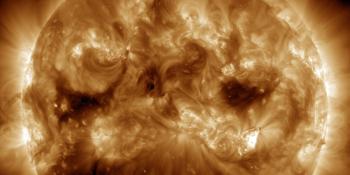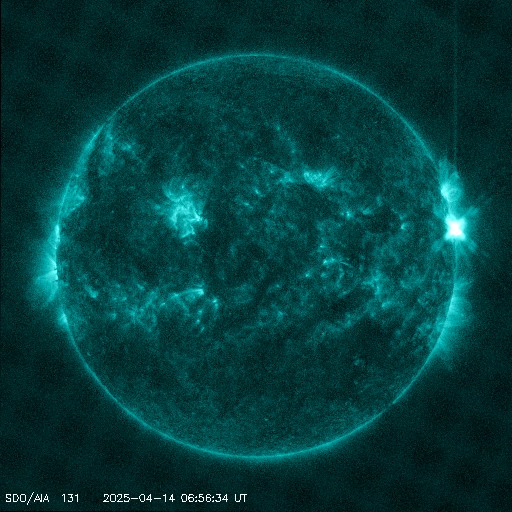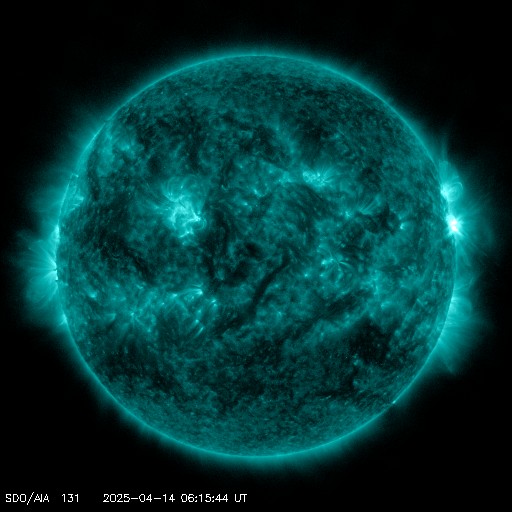Viewing archive of Friday, 6 February 2004
Solar activity report
Any mentioned solar flare in this report has a scaling factor applied by the Space Weather Prediction Center (SWPC). Because of the SWPC scaling factor, solar flares are reported as 42% smaller than for the science quality data. The scaling factor has been removed from our archived solar flare data to reflect the true physical units.
Report of Solar-Geophysical Activity 2004 Feb 06 2200 UTCPrepared by the NOAA © SWPC and processed by SpaceWeatherLive.com
Joint USAF/NOAA Report of Solar and Geophysical Activity
SDF Number 037 Issued at 2200Z on 06 Feb 2004IA. Analysis of Solar Active Regions and Activity from 05-2100Z to 06-2100Z
Solar activity decreased to very low levels. The
activity today consisted of several minor low level B-class flares.
Region 551 (S06E13) has shown some growth in penumbral coverage
since yesterday. The gamma structure in the trailing portion of the
region remains intact. Region 549 (N14W09) has undergone decay in
sunspot count and areal coverage. No new regions were numbered
today.
IB. Solar Activity Forecast
Solar activity is expected to be at
low levels. Region 551 has the potential to produce an isolated low
level M-class flare.
IIA. Geophysical Activity Summary 05-2100Z to 06-2100Z
The geomagnetic field was at quiet to active levels. A period of
minor storm conditions were observed at high latitudes between
06/0300 and 0600Z due to a high speed stream (near 600km/s) and
sustained southward Bz. The greater than 2 MeV electron fluxes at
geosynchronous orbit reached high levels today.
IIB. Geophysical Activity Forecast
The geomagnetic field is
expected to range from predominantly quiet to active levels
throughout the period. Day three may experience isolated minor
storm conditions at high latitudes due to a recurrent coronal hole
high speed stream.
III. Event Probabilities 07 Feb to 09 Feb
| Class M | 20% | 20% | 20% |
| Class X | 01% | 01% | 01% |
| Proton | 01% | 01% | 01% |
| PCAF | green | ||
IV. Penticton 10.7 cm Flux
Observed 06 Feb 107 Predicted 07 Feb-09 Feb 110/110/110 90 Day Mean 06 Feb 119
V. Geomagnetic A Indices
Observed Afr/Ap 05 Feb 008/014 Estimated Afr/Ap 06 Feb 015/019 Predicted Afr/Ap 07 Feb-09 Feb 012/015-010/015-010/020
VI. Geomagnetic Activity Probabilities 07 Feb to 09 Feb
| A. Middle Latitudes | |||
|---|---|---|---|
| Active | 25% | 25% | 25% |
| Minor storm | 10% | 10% | 10% |
| Major-severe storm | 05% | 01% | 01% |
| B. High Latitudes | |||
|---|---|---|---|
| Active | 35% | 35% | 40% |
| Minor storm | 15% | 15% | 20% |
| Major-severe storm | 05% | 05% | 10% |
All times in UTC
Current data suggests there is a slight possibility for aurora to appear at the following high latitude regions in the near future
NuukReykjavik
Latest news
Latest forum messages
2025/04/12-13 Filament CMEs 2025/04/16 G2 Watch 41AR 4055 99Incoming & Unnumbered Active Regions 1700Unspecified geomagnetic activity 2258Potential AR4062 8
More topicsSupport SpaceWeatherLive.com!
A lot of people come to SpaceWeatherLive to follow the Sun's activity or if there is aurora to be seen, but with more traffic comes higher server costs. Consider a donation if you enjoy SpaceWeatherLive so we can keep the website online!

Latest alerts
Monday, 14 April 2025
23:15 UTC - Geomagnetic activity
Active geomagnetic conditions (Kp4) Threshold Reached: 23:01 UTC
07:09 UTC - Solar flare
Moderate M4.28 flare from sunspot region 4055
06:48 UTC - Radio Blackout
Minor R1 radio blackout in progress (≥M1 - current: M1.53)
06:24 UTC - Solar flare
Moderate M1.49 flare from sunspot region 4055
06:06 UTC - Radio Blackout
Minor R1 radio blackout in progress (≥M1 - current: M1.16)
Space weather facts
| Last X-flare | 2025/03/28 | X1.1 |
| Last M-flare | 2025/04/14 | M4.2 |
| Last geomagnetic storm | 2025/04/06 | Kp5 (G1) |
| Spotless days | |
|---|---|
| Last spotless day | 2022/06/08 |
| Monthly mean Sunspot Number | |
|---|---|
| March 2025 | 134.2 -20.4 |
| April 2025 | 132.1 -2.1 |
| Last 30 days | 130.6 -13.6 |





